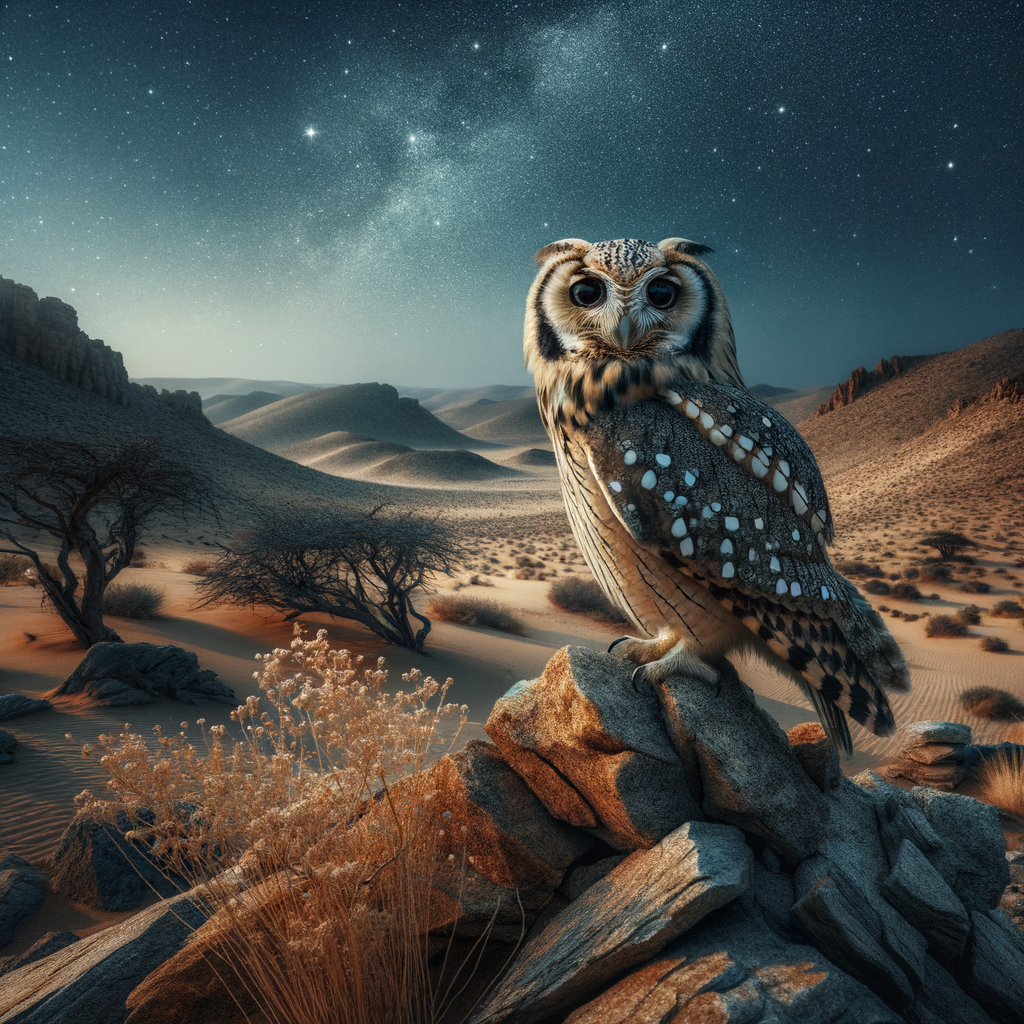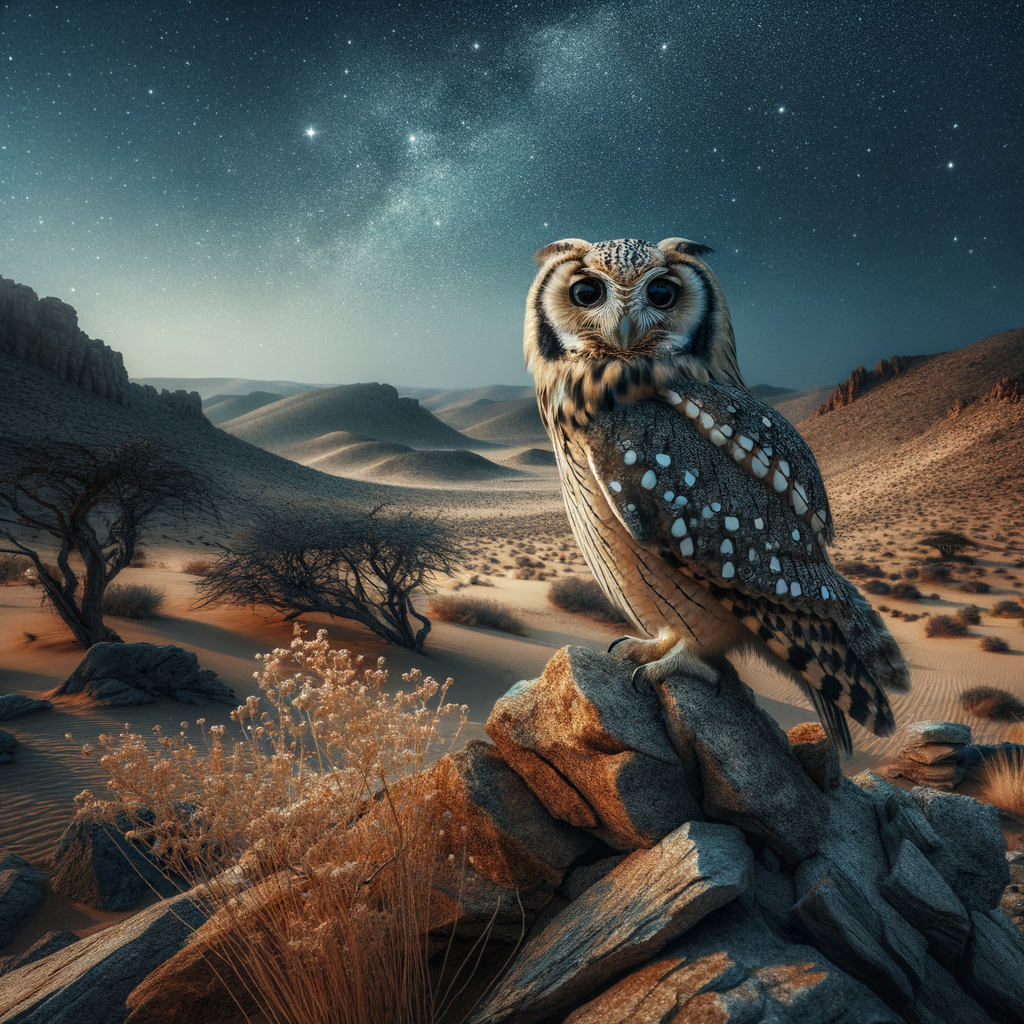
Introduction to Desert Owls
-
- Overview of Desert Owls
Desert owls are a unique group of birds that live in some of the harshest environments on Earth. These owls have special features that help them survive in hot, dry places. They are known for their keen eyesight and silent flight, which make them excellent hunters.
-
- Importance of Understanding Desert Owl Characteristics
Learning about desert owls is important because it helps us understand how animals adapt to extreme conditions. By studying their behavior and physical traits, we can learn more about survival in deserts. This knowledge can also help in conservation efforts to protect these amazing birds.
Desert Owl Species
Common Desert Owl Species
- Great Horned OwlOne of the most well-known owls in the desert. It has large ear tufts that look like horns. This owl is very adaptable and can live in many different environments, including deserts.
Great Horned Owls are powerful hunters. They can catch prey much larger than themselves. Their diet includes small mammals, birds, and reptiles.
- Elf OwlThe smallest owl in the world. It is about the size of a sparrow. These tiny owls live in the desert and make their homes in cactus holes or tree cavities.
Elf Owls are nocturnal, which means they are active at night. They eat insects and small animals. Despite their small size, Elf Owls are very skilled hunters.
- Burrowing OwlIs unique because it lives in burrows in the ground. These owls are often found in open areas like deserts and grasslands. They use burrows made by other animals or dig their own.
Burrowing Owls are active during the day and night. They have long legs, which help them run after prey. Their diet includes insects, small mammals, and birds.
Desert Owl Adaptations
Physical Adaptations
-
Camouflage and its role in survival:
Desert owls have feathers that blend in with their sandy surroundings. This camouflage helps them hide from predators and sneak up on prey. For example, the Elf Owl’s feathers match the color of tree bark, making it hard to spot.
-
Adaptations for hunting:
Desert owls have sharp talons and beaks to catch and eat their prey. They also have excellent night vision, which helps them hunt in the dark. Their silent flight is another key adaptation, allowing them to surprise their prey without being heard.
Behavioral Adaptations
-
Nocturnal Behavior of Desert Owls
Desert owls are mostly active at night. This is called being nocturnal. By being active at night, they avoid the hot daytime temperatures. This helps them save energy and stay cool.
At night, desert owls have an advantage. Their excellent night vision allows them to see in the dark. They can spot small animals like mice and insects easily. This makes hunting at night easier for them.
According to Wikipedia, many owl species have evolved to be nocturnal to avoid predators and competition for food.
-
Hunting Techniques
One technique is called “perch and pounce.” They sit quietly on a high perch and watch for movement. When they see a small animal, they swoop down quickly to catch it.
Another technique is “hover and listen.” The owl hovers in the air and listens for sounds of small animals moving. Their sharp hearing helps them locate prey even if they can’t see it.
These hunting techniques are very effective. They help desert owls find food in their harsh environment.
Desert Owl Habitat
- Typical habitats of desert owls:These areas have very little water and lots of sand. You can find them in deserts like the Sahara, the Mojave, and the Arabian Desert. They often make their homes in rocky crevices, caves, and even old burrows made by other animals.
- Adaptations to desert environments:They have light-colored feathers to blend in with the sandy environment. Their feathers also help keep them cool during the day and warm at night. These owls are mostly active at night, which helps them avoid the extreme heat of the day.
Another important adaptation is their ability to get water from their food. They eat small mammals, insects, and other birds, which provide the moisture they need. This means they don’t have to find water sources often.
Desert Owl Diet
- Common prey of desert owls: Their diet includes rodents, insects, and small birds. Sometimes, they also catch lizards and snakes. These owls are skilled hunters and can catch prey in the dark.
- Role of diet in desert owl survival: They need to eat enough food to stay strong and healthy. In the desert, food can be hard to find. Owls must be good hunters to get enough to eat. Their diet helps them stay active and reproduce. Without enough food, they cannot survive in the harsh desert environment.
Desert Owl Behavior
Mating and Reproduction
- Mating rituals of desert owls: During the mating season, male owls perform special calls and dances to attract females. These displays show their strength and health. Some species also bring food to the female as a gift.
- Reproductive adaptations for desert survival: They often nest in shaded areas to protect their eggs from the scorching sun. Their eggs have thicker shells to retain moisture. Additionally, desert owls time their breeding season to coincide with periods when food is more abundant, ensuring their chicks have enough to eat.
| Adaptation | Purpose |
|---|---|
| Special calls and dances | Attracting mates |
| Nesting in shaded areas | Protecting eggs from heat |
| Thicker eggshells | Retaining moisture |
| Timing breeding season | Ensuring food availability for chicks |
Interactions with Other Species
- Desert owls and their predators: Larger birds like eagles and hawks often hunt them. Sometimes, snakes and mammals like foxes also pose a threat. To stay safe, desert owls use their keen senses and camouflage. They blend in with their surroundings to avoid being seen.
- Desert owls and their prey: They mostly eat small mammals like mice and rats. They also catch insects, lizards, and sometimes even small birds. Their sharp talons and excellent night vision help them catch prey easily. By controlling the population of these animals, desert owls play an important role in their ecosystem.
Desert Owl Conservation
-
Current Conservation Status of Desert Owls
Desert owls face many challenges. Some species are listed as endangered or vulnerable. This means they are at risk of becoming extinct. Habitat loss and climate change are major threats. For example, the Pharaoh Eagle-Owl is one species that is closely monitored.
-
Efforts to Protect and Conserve Desert Owls
They create protected areas where owls can live safely. They also work on restoring habitats. Education programs teach people about the importance of owls. For instance, the World Wildlife Fund runs several conservation projects.
Here are some key efforts:
- Protected Areas: Special zones where human activity is limited.
- Habitat Restoration: Rebuilding natural environments.
- Education Programs: Teaching communities about conservation.
These efforts help ensure that desert owls can thrive for years to come.
Conclusion: The Fascinating World of Desert Owls
Desert owls are truly amazing creatures. They have unique adaptations that help them survive in harsh environments. Let’s recap some key points and understand why it’s important to protect these wonderful birds.
-
Recap of key points:
- Desert owls have special features like silent flight and sharp vision.
- They live in various desert regions around the world.
- These owls eat small animals like rodents and insects.
- They have interesting behaviors, such as hunting at night.
-
Importance of desert owl conservation:
- Desert owls help control the population of small animals.
- They are part of the ecosystem and help keep it balanced.
- Many desert owls are threatened by habitat loss and climate change.
- Protecting them ensures the health of desert environments.
By understanding and protecting desert owls, we help preserve the delicate balance of nature. These birds are not just fascinating; they are vital to their habitats. Let’s work together to ensure they continue to thrive.






